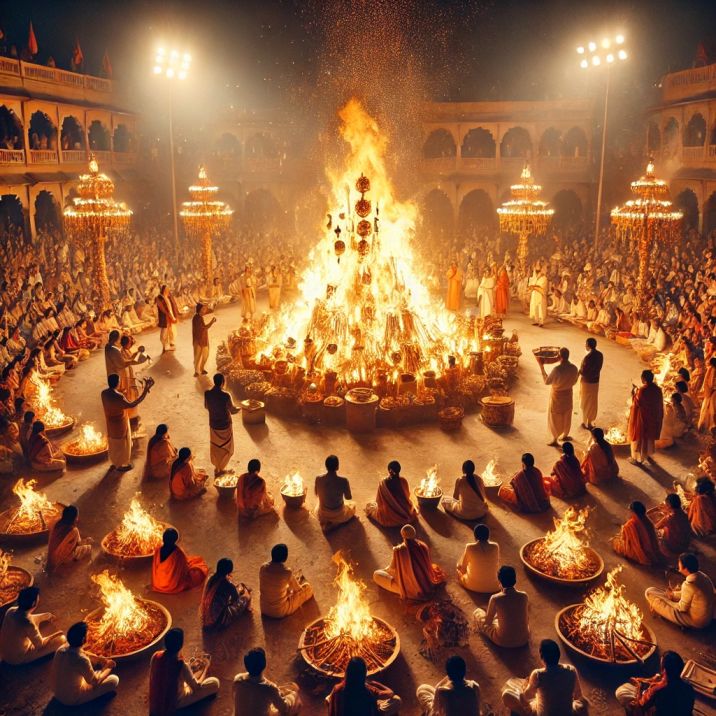
Holi, the festival of colors, is one of the most joyous and widely celebrated festivals in India. It marks the arrival of spring and symbolizes love, happiness, and the victory of good over evil. The festival is celebrated with enthusiasm, bringing people together regardless of age, caste, or religion. Before the grand celebrations of colors, Holika Dahan, an important ritual, takes place on the eve of Holi. This bonfire ceremony signifies the triumph of good over evil and is deeply rooted in Hindu mythology.
In this blog, we will explore the significance, traditions, and celebrations of Holi and Holika Dahan in India.
History and Mythology of Holi
The origins of Holi can be traced back to various mythological stories. The most prominent legend associated with Holi is that of Prahlad and Holika.
According to Hindu mythology, there was once a demon king named Hiranyakashipu, who wanted everyone to worship him instead of Lord Vishnu. However, his son Prahlad was a devoted follower of Vishnu. Hiranyakashipu was furious and sought to kill his own son. He sought the help of his sister Holika, who had a divine cloak that made her immune to fire. She tricked Prahlad into sitting with her in a fire, thinking he would perish. However, due to his unwavering devotion, Vishnu saved Prahlad, while Holika burned to ashes. This event is commemorated as Holika Dahan, symbolizing the victory of good over evil.
Another famous story is that of Radha and Krishna. Lord Krishna, known for his playful nature, was concerned about his dark complexion compared to Radha’s fair skin. His mother, Yashoda, playfully suggested that he color Radha’s face with gulal. This act led to the tradition of playing with colors during Holi.

Holika Dahan: The Bonfire Ceremony
When is Holika Dahan Celebrated? Holika Dahan is observed on the night before Holi, known as Choti Holi. It usually falls on the full moon night of the Hindu month Phalguna (February-March).
Significance of Holika Dahan The ritual of Holika Dahan signifies the burning away of evil forces and negativity. It encourages people to let go of past grudges, anger, and hatred, embracing love and harmony.
Rituals of Holika Dahan
- Gathering Firewood: People collect wood and combustible materials to prepare a large bonfire.
- Creating an Effigy: An effigy of Holika, symbolizing evil, is placed in the bonfire.
- Puja and Offerings: Families perform prayers and offer roli (red powder), turmeric, coconut, and grains to the fire.
- Burning the Fire: The bonfire is lit, and people chant religious hymns while walking around it, seeking blessings.
- Holika Ashes: The next day, devotees apply the sacred ash from the fire on their foreheads, believing it protects them from evil.
Holi: The Festival of Colors

After the night of Holika Dahan, Holi is celebrated with unmatched joy and enthusiasm. It is a day filled with colors, music, dance, and laughter.
How is Holi Celebrated?
- Playing with Colors: People smear each other with gulal (dry colors) and splash colored water.
- Water Balloons and Pichkaris: Children and adults enjoy throwing water balloons and spraying colors using water guns.
- Traditional Sweets: Delicious sweets like gujiya, malpua, and thandai are prepared and shared.
- Music and Dance: People gather in groups, playing dhol (drums) and dancing to folk and Bollywood Holi songs.
- Community Bonding: Friends and families visit each other, applying colors and exchanging greetings.
Regional Variations of Holi
Holi is celebrated differently across India, with each region adding its unique traditions:
- Lathmar Holi (Barsana & Nandgaon, Uttar Pradesh): Women playfully beat men with sticks, recreating the playful teasing of Radha and Krishna.
- Basant Utsav (West Bengal): Inspired by the poetry of Rabindranath Tagore, people wear yellow outfits and celebrate with cultural performances.
- Shigmo (Goa): A grand parade with folk dances and vibrant costumes marks the festival.
- Royal Holi (Rajasthan): Celebrated with grand processions, elephant parades, and folk performances.
- Holi in Mathura & Vrindavan: A week-long celebration in Krishna’s birthplace with temple rituals and flower Holi.
The Spiritual and Social Importance of Holi
Holi is more than just a festival of colors; it fosters unity, friendship, and social harmony. It erases social barriers and brings people together in the spirit of joy. The festival also holds spiritual significance, reminding us of the power of good over evil and the importance of love, forgiveness, and new beginnings.

Conclusion
Holi and Holika Dahan are deeply rooted in Indian culture, symbolizing joy, togetherness, and positivity. As you celebrate this festival, remember its rich traditions and significance. Play safe, respect others, and spread happiness with colors.
Wishing you all a very Happy and Colorful Holi!
